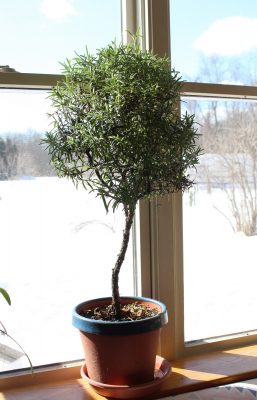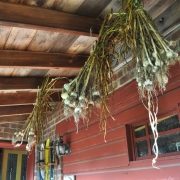Rosemary Tips
Secrets to Survival
I’ve killed plenty of rosemary plants over the years, typically in late winter. At least that’s when I’d discover that they were dead. Casually brushing against the plant would bring dried leaves raining to the floor.

Problem is that rosemary has naturally stiff leaves. They don’t wilt to broadcast that the plant is thirsty. And then it’s too late; the plant tells you it’s dead as it’s leaves flicker down.
Perhaps like you, I knew that rosemary is native to the Mediterranean region. The picture in my mind is of the plants thriving on a sun-drenched, dry, rocky hillside in poor soil. True enough, except below ground the roots are reaching deep or wide for water. Which my potted plants can’t do.
Following this latter realization — duh! — I haven’t lost a rosemary plant in years. The secret to keeping a potted rosemary plant happy is to keep it well watered, never letting the potting mix dry out. If in doubt, water.
Rosemary roots also need to breathe, and the way that is assured is by adding plenty of perlite to the potting mix. My mix is 1/4 by volume each of perlite, garden soil, compost, and peat moss. The latter two ingredients help retain moisture while, at the same time, provide for aeration.
Making a Rosemary Tree
I mentioned last week that I grow my rosemary plants as miniature trees, a form also known as “standards.” Here’s how I make mine.
(“Standard” does seem like an odd word to describe such a plant until you realize that the “stand” in “standard” does indeed mean just that. “Standard” comes from the Old English words standan, meaning to stand, rather than flop around, and ord, meaning a place. Further muddying the horticultural waters, in fruit growing a “standard” is a full size tree, as opposed to a dwarf tree.)
The easiest way to set a rosemary plant on the road to standard-dom is to begin with a small plant. Rosemary comes in upright or creeping varieties. Upright varieties, such as Majorca Pink and Salem, are naturally inclined to “stand,” but creeping varieties are also easily coaxed in this direction.
Single out a vigorous and upright growing stem as the standard’s future trunk. In the case of a creeping variety, just select any healthy stem and stake it upright to a dowel or thin shoot of bamboo. Shorten all side shoots to direct the plant’s energy into that trunk-to-be.

The goal, in the weeks ahead, is to promote elongation and thickening of the trunk-to-be. To that end, keep cutting away any new stems sprouting from the base of the plant. Keep pinching back to just a few leaves any side shoots. Doing so keeps them subordinate but lets them help thicken the trunk.
Once the trunk reaches full height, goals change: time to stop growth and create a bushy head. But how high is “full height?” It’s all for show, and what looks good depends on how big a head you are going to give the plant and how big a pot the plant will eventually call home. Generally, a head two to three times the height and just slightly more than the width of the pot looks good. Stop growth at the desired height by pinching out the tip of the trunk, a simple operation that awakens growth of buds down along the trunk.

Create the bushy head by repeatedly pinching — and thus inducing more branching — all growth that sprouts from the top few inches of the trunk. Now define that head more clearly by completely removing all stems and leaves further down the trunk.
All these prunings need not be wasted, of course. They could be used as flavoring or as cuttings to make yet more plants.
(Creating standards and other methods of pruning all plants is covered in more detail in my book, The Pruning Book, available from the usual sources or, signed by me if you wish, here.)
On Going Rosemary Tree Care
Over time, the bushy head grows larger and larger — too large if left unfettered. So pinch back growing tips regularly, which you’ll probably be doing anyway as you enjoy the rosemary added to tomato sauce or chopped and sprinkled on fish. Unless you’re crazy for rosemary, that amount of pruning won’t be enough to contain the ever expanding head.
And below ground, roots eventually fill their flowerpot. Then they will need more room and access to more nutrients. So once a year, in spring, I tip my plant out of its pot, shear off some roots and soil around the edge of the root ball, then put it back in the pot with new potting mix in the space opened up.

Right after I repot the plant, I also give it its annual haircut, shearing the head an inch or so back all over with a pruning or grass shears. Water well and watch the plant fill out with new growth.
All those shearings could, of course, be dried for future use. But why do that? You now have plenty of fresh rosemary, year ‘round. Just don’t neglect watering.





I kill my rosemary every year – this gives me hope! Do you bring the rosemary pot outside in summer?
Yes, my rosemaries spend summers outdoors, basking in sunlight and fresh air.
Usually I pinch my rosemary, and usually kill it over winter. But last year I didn’t touch it, and it’s covered with little blue flowers. I finally figured that yes you are supposed to water it a lot in the winter, and I think that’s why mine is still alive and happy today.
Well in the south, we have giant rosemary year around, so it makes the 109F summers tolerable! I was at my son’s playmate birthday party & notice 6 rosemary plants in a circle & they had grown til they touched. I stared at them trying to figure out the herb design, when the owner walked over. He said it is rosemary. I said I know just looking at the design. He lol & said I bought these little plants & had no ideal that they would get so big.
So happy for these tips on keeping rosemary alive during winter. I have not had success to date, so perhaps this is the wisdom I needed. Thank you!
I just bought ANOTHER Rosemary plant. Perfect timing for me to read your blog. I kill it every year. Thank you
Glad to be of help.
Wonderful advice . Going to try with one that has been out all summer. I realize cutting side branches now may shock the plant and so how would I take those cuttings to start a new plant. Thanks again for such a useful, clear article
Excellent article, I’m going to give rosemary another try
Thank you.
Lee,
Do you have a plan or can you provide directions for building the rustic branch arbor pictured on your website?
Thanks,
Jan
Definitely no plan! I just harvested various sizes of locust wood and branches, peeled the bark, and began, designing as I built.
I was bumbing around the net looking for horseradish & found 8 or 9 variteries of Rosemary & one has yellow leaves>
I do not know this site, but wanted to give you a chance to look at it.
https://www.mountainvalleygrowers.com/Rosemary.htm
Appreciate the blog post. Once Covid19 wanes here I will begin creating a rosemary tree as you have excellent instruction. I had no idea to over water in winter – that’s a fear I always had that I may kill it. Thanks for your post.